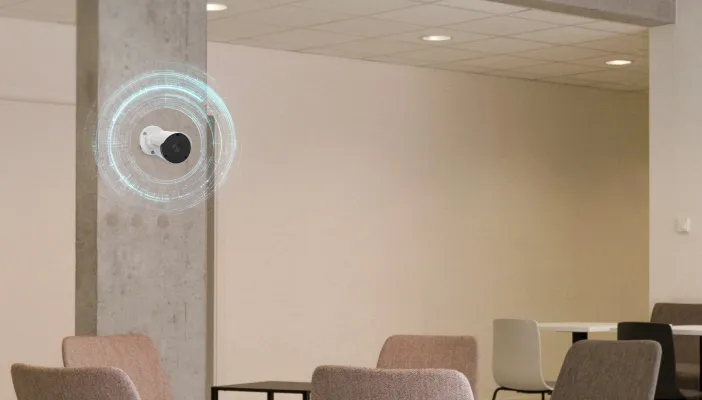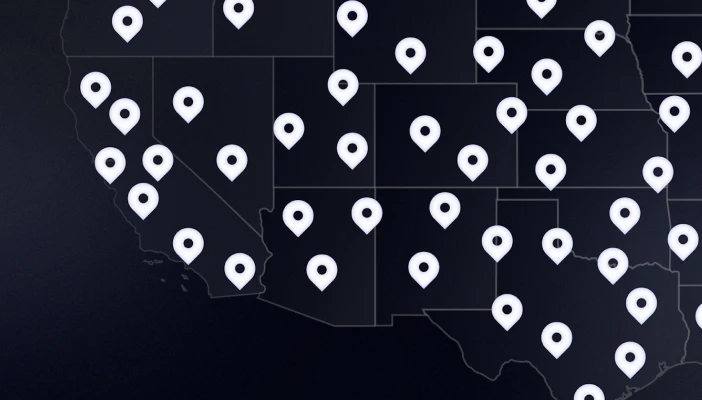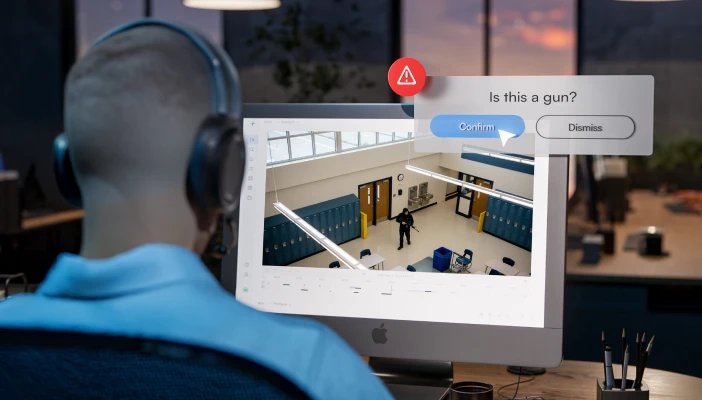The capabilities and performance of AI security cameras can vary significantly. Based on our research on over a dozen AI video security systems, we've identified four essential features every AI solution should possess.
AI is transforming various industries, including physical security. Organizations are increasingly adopting AI security solutions to improve safety, streamline operations, and enhance efficiency. However, the performance of AI video security solutions can vary significantly across vendors, making it challenging to determine the best option.
Given the numerous variables involved—such as hardware infrastructure, software applications, AI analytics and processing, system operation and functionality, and cybersecurity protocols—choosing the right system can be daunting. To help cut through the noise, here are the four key features every AI security camera system should have to deliver the best possible experience for your organization.
Feature 1: End-to-End AI Video Security System
An end-to-end AI video security system offers a more seamless and efficient experience compared to a piecemeal approach where various vendors provide cameras, software, and AI. End-to-end systems offer significant advantages, such as:
- Easy Deployment and Management: An all-in-one system simplifies your experience, reducing the need for multiple vendors and ensuring everything works together as intended.
- More Innovation: Vendors that offer a complete platform—including hardware, software, and AI—can innovate faster, ensure high-quality standards in performance and user experience, and provide the latest features as soon as they become available.
- Reduced Integration Issues: With a single vendor responsible for the entire system, there are fewer integration hiccups, reliability issues, and faster support resolution if problems arise.
Many video security systems claim AI features but often fall short upon closer inspection. Combining surveillance hardware, video management software, and multiple AI providers can create a disjointed experience with various points of failure. A complete, end-to-end AI video security system eliminates these issues, providing a more reliable and efficient solution.
When selecting a system, look for a vendor that builds its own AI and provides a complete platform that supports computer vision, machine learning, and visual AI applications. This ensures that the hardware, software, and AI components are designed to work together seamlessly, ensuring smoother performance and reliability over the long run.

Feature 2: Distributed Hybrid Cloud Architecture
A distributed hybrid cloud system contains on-premise cloud-connected hardware, enabling remote access, seamless communication between connected devices, and modern system management. Most processing occurs on the edge, with local devices and the cloud working together to deliver a complete experience.
Distributed hybrid cloud architecture combines the best features of on-premises and cloud systems while minimizing drawbacks. This architecture provides significant benefits, including:
- Real-Time Performance: On-premises systems offer real-time performance but are siloed and difficult to manage. With a distributed hybrid cloud solution, you still receive the same real-time performance as an on-premise system but with greater usability and efficiency due to cloud connectivity.
- Easy Management and Access: Hybrid cloud systems simplify management and access. Unlike pure cloud systems with limited processing power or high bandwidth consumption, hybrid cloud solutions process and operate primarily on local devices and communicate to the cloud only when necessary.
- Optimal AI Processing: Distributed hybrid cloud architecture leverages local and cloud resources to provide maximum computing and processing power at scale while balancing efficiency and costs. This setup allows for real-time AI processing without impacting bandwidth or requiring a massive investment in local servers.
When selecting an AI security camera system, opt for one built on a distributed hybrid cloud architecture. This ensures the system can deliver a reliable and easy-to-manage experience and handle current AI processing loads with the capability to adapt to future technological advancements.
Feature 3: Dedicated GPUs for Advanced AI Processing
Many of today’s video security systems rely on in-camera chipsets or outdated processors that cannot handle the heavy workloads associated with advanced AI processing. The type of processor used significantly influences how well a system can perform when handling object recognition, event detection, and AI analytics.

Dedicated Graphics Processing Units (GPUs) are designed to manage complex computations and heavy processing tasks, making them essential for any robust AI system. The advantages of dedicated GPUs over other types of processors include:
- Enhanced Processing Power: GPUs are built for parallel processing, enabling them to manage multiple tasks simultaneously. This capability is crucial for running advanced AI models that require significant computational power, such as real-time facial recognition, object detection, deep learning, and behavioral analysis. Systems with dedicated GPUs can process and analyze high-resolution video streams without performance degradation.
- Future-Proofing: As AI technology evolves, the demand for processing power will increase. Dedicated GPUs ensure your AI security camera system remains relevant and effective, handling new and sophisticated AI algorithms and applications. Suppose a video security system uses in-camera chipsets or processors not designed for AI. In this particular case, this puts the system at a severe disadvantage, as an upgrade will most likely be needed in the immediate future if an organization ever has plans to use AI to improve security, safety, and operations.
GPUs power many of today’s most powerful AI solutions. If you want to ensure your organization is set up for success and can properly leverage the power of AI in the coming years, choosing a video security solution with GPU processors is essential.
Feature 4: Continuous-Learning AI Models
Many AI security systems rely on static, off-the-shelf models not tailored to specific environments, leading to a one-size-fits-all approach. This compromises performance and accuracy as these models cannot adapt to your unique needs and requirements. Continuous-learning AI models, however, offer several critical advantages to ensure your security system operates in a way that best aligns with your organization.
- Tailored Performance to Your Environment: Continous-learning AI models adjust to the specific characteristics of each environment, such as lighting, layout, and activity patterns. This real-time customization allows for more accurate detection and analysis, reducing false alerts and missed events.
- Dynamic Learning: Unlike static models, continuous models learn from new video data, driving consistent performance improvements. As the model is exposed to more scenarios, the algorithms refine and adjust to your organization's unique patterns and events, providing faster, more accurate, and more predictive detection capabilities.
- Operational Efficiency: Continuous-learning models reduce the need for manual adjustments and frequent recalibrations, as everything happens automatically, saving time and resources. These models maintain optimal performance with minimal human intervention, streamlining security operations.
Every environment is unique, so selecting a security solution incorporating continuous-learning AI models will deliver superior performance, faster event detection, and greater accuracy. This adaptability ensures that the system remains effective in varying conditions and evolves with emerging security challenges.
Conclusion
Investing in an AI security camera system is a significant decision that can enhance your organization's security and efficiency—by focusing on end-to-end systems, distributed hybrid cloud architecture, dedicated GPUs, and continuous-learning AI models, you ensure that the security camera solution you select meets your current needs while adapting to future advancements. Prioritizing these key aspects will ensure you receive a powerful and scalable solution that will deliver the most ROI and ultimately help safeguard your organization now and in the future.








